
COLOR SOUNDER

Nishinomiya
Pub. No.
( DAMI )
The paper used in this manual is elemental chlorine free.
FURUNO Authorized Distributor/Dealer
FIRST EDITION : FEB. 2005
D : MAY. 16, 2006
*00015183503*
*00015183503*
* 0 0 0 1 5 1 8 3 5 0 3 *
*OME23730D00*
*OME23730D00*
* O M E 2 3 7 3 0 D 0 0 *

IMPORTANT NOTICES
???No part of this manual may be copied or reproduced without written permission.
???If this manual is lost or worn, contact your dealer about replacement.
???The contents of this manual and equipment specifications are subject to change without notice.
???The example screens (or illustrations) shown in this manual may not match the screens you see on your display. The screen you see depends on your system configuration and equipment settings.
???This manual is intended for use by native speakers of English.
???FURUNO will assume no responsibility for the damage caused by improper use or modification of the equipment or claims of loss of profit by a third party.
???Dispose of the equipment according to appropriate regulations.
i


 SAFETY INSTRUCTIONS
SAFETY INSTRUCTIONS
 WARNING
WARNING
ELECTRICAL SHOCK HAZARD
Do not open the equipment.
Only qualified personnel should work inside the equipment.
Immediately turn off the power at the switchboard if water leaks into the equipment or something is dropped in the equipment.
Continued use of the equipment can cause fire or electrical shock. Contact a FURUNO agent for service.
Do not disassemble or modify the equipment.
Fire, electrical shock or serious injury can result.
Do not place
Fire or electrical shock can result if a liquid spills into the equipment.
Immediately turn off the power at the switchboard if the equipment is emitting smoke or fire.
Continued use of the equipment can cause fire or electrical shock. Contact a FURUNO agent for service.
Make sure no rain or water splash leaks into the equipment.
Fire or electrical shock can result if water leaks in the equipment.
 WARNING
WARNING
Keep heater away from equipment.
A heater can melt the equipment's power cord, which can cause fire or electrical shock.
Use the proper fuse.
Fuse rating is shown on the equipment. Use of a wrong fuse can result in damage to the equipment.
Do not operate the equipment with wet hands.
Electrical shock can result.
Warning Labels
Warning labels are attached to the equip- ment. Do not remove the labels. If a label is missing or damaged, contact
a FURUNO agent or dealer about replace- ment.
ii
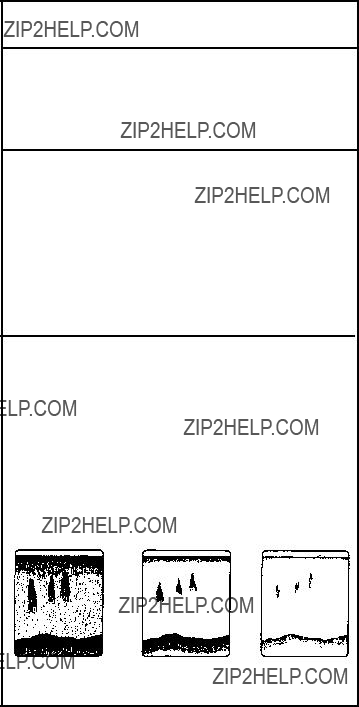
 CAUTION
CAUTION
Do not transmit when the transducer is out of water.
The transducer may become damaged.
The picture does not advance when the picture advance speed is set for "STOP".
A dangerous situation may result if the vessel is navigated while monitoring
the depth indication since it is not updated when the picture is stopped.
Set the gain properly.
No picture appears if the gain setting is too low, and noise appears when the gain is too high. If the gain is set improperly, the depth indication may be wrong,
resulting in a potentially dangerous situation if the vessel is navigated by monitoring
the depth indication.
Gain too high Proper gain Gain too low
iii
TABLE OF CONTENTS
iv
v

FOREWORD
Introduction
FURUNO Electric Company thanks you for considering and purchasing the
For over 50 years FURUNO Electric Company has enjoyed an enviable reputation for quality and reliability throughout the world. This dedication to excellence is furthered by our extensive global network of agents and dealers.
Your equipment is designed and constructed to meet the rigorous demands of the marine environment. However, no machine can perform its intended function unless properly installed and maintained. Please carefully read and follow the operation and maintenance procedures set forth in this manual.
We would appreciate feedback from you, the
Thank you for considering and purchasing FURUNO.
Features
The
The main features of the
???Stabilization compensation in all directions (all directions ??20??) provides stable images in rough seas.
???Fish distribution and size can easily be found using the fish histogram display.
???Detection in
???Target graph lets you monitor fish movement.
???Bottom hardness and roughness graph provides intuitive data on bottom composition.
???User programmable display (three types) divides the screen in two, three, four or five displays.
???Various alarms: bottom, bottom fish, fish, temperature, vertical temperature. (Temperature alarms requires appropriate sensor. The vertical temperature alarm additionally requires a net sonde or trawl sonar.)
???USB port provided to save data to USB hard disk.
vi

SYSTEM CONFIGURATION
F1
F2
F3
F4
POWER
1??, 50/60 Hz
Transceiver Unit
1??, 50/60 Hz
Junction Box (option)
Transducer
System configuration
.
Monitor Unit
Navigator
Satellite Compass
Net Sonde
Hard Disk
USB Memory
Network Sounder
vii
This page intentionally left blank.
viii

1.OPERATIONAL OVERVIEW
1.1Controls
Control unit

1. OPERATIONAL OVERVIEW
1.2Menu Operation
The
1.2.1How to use the main menu
Menu bar
1.Roll the trackball to choose menu desired (File, Disp, Setting, System, etc.) from the menu bar at the top of the screen and the click it with the left button.
 Ellipsis indicates a dialog box is available
Ellipsis indicates a dialog box is available
Setting menu
2.Roll the trackball to choose menu item desired and then click with the left button. A menu item which contains an ellipsis (???) indicates a dialog box is available.
Tenkey  button
button
Multi beam dialog box

1. OPERATIONAL OVERVIEW
3.Change settings as appropriate, referring to the information below.
4.After changing settings, roll the trackball to place the pointer on the OK button and then push the left button to save settings and close the dialog box. (See Note 3 below.)
Note 1: To restore previous settings, click the Cancel button instead of the OK button at step 4.
Note 2: To see the result of a change without closing a dialog box, click the Apply button.
Note 3: Unless otherwise noted, the phrase ???click?????? means to click the object with the left mouse button.
Changing setting using radio buttons
Enabled Disabled
Radio buttons
Click the item desired. A black dot appears when the item selected is enabled.
Changing setting using a list box
Normal
List box
1.Click ??? in the list box or click the box itself to show a list of options.
2.Click the desired setting.
Changing setting using a spin box
Spin box
A setting may be changed from a spin box two ways depending on contents of the spin box:
1)Click ??? or ??? successively in the spin box to choose the setting desired. Each click increments the setting downward or upward depending on arrow clicked.
2)Spin the thumbwheel to choose value with the cursor.
Cursor 

Spin box
Place the pointer on the ???tenkey??? button ( ) at the lower
) at the lower

1. OPERATIONAL OVERVIEW
Tenkey
Close
Tenkey panel
Place the cursor on the desired numeric key and then push the left button. Repeat to enter all data required.
Changing setting using a check box
Bottom alarm
1.Place the pointer on the check box of the item you want to enable or disable.
2.Push the left button to remove or insert the check mark as appropriate. An item is enabled when the check mark is present.
Changing setting using a toggle button
1.Click the item desired.
2.Each click enables or disables your selection alternately. When the item selected is enabled it is highlighted in dark blue and when disabled it is colored gray.

1. OPERATIONAL OVERVIEW
1.2.2How to use the
1.
 Indicates an option menu is available
Indicates an option menu is available
2.Click the item desired. An item with ??? indicates an option window; ????????? (ellipsis) a setting window. Currently selected option is marked with a filled circle.
Option window for "Mode".
Sliding bar
Track
bar
Close button 
3. Do one of the following according to item selected.
Operation from an options window
Roll the trackball to execute appropriate operation and then push the left button.
Operation from a setting window
There are three settings methods:
???Drag the sliding bar: Place the pointer on the sliding bar and hold down the left button while rolling the trackball.
???Place the pointer on the track bar and then click with the left button
???With the track bar selected, spin the thumbwheel and roll the thumbwheel downward to increment figure upward; upward to increment figure downward. If the drag bar is not selected, place the pointer on it and push the left button.
Finally, click the Close button.

1. OPERATIONAL OVERVIEW
1.3Turning the Power On/Off
Turning on the power
1.Turn on the monitor.
2.Open the power switch cover on the Control Unit and push the  switch. The power comes on, Windows??* starts up, the FCV30 application launches and then the
switch. The power comes on, Windows??* starts up, the FCV30 application launches and then the
Windows is the registered trademark of Microsoft, Inc.
Note that the Windows?? Help feature is not available with this equipment.
Turning off the power
There are two methods to turn off the power.
a)Press the  switch. Do not press the switch more than four seconds;
switch. Do not press the switch more than four seconds;
b)Click the close button ( ). The following window appears. Then, click the Yes button to quit.
). The following window appears. Then, click the Yes button to quit.
Confirmation
Are you sure to quit?
[No
Shutdown confirmation window
Note: Power is automatically turned off anytime the processor unit is disconnected from the control unit.

1. OPERATIONAL OVERVIEW
1.4Transmitting, Receiving
Follow the procedure below to start transmitting and receiving, after turning on the power.
1. Click File.
File menu
2. Click TX Start. Transmission starts and images from underwater appear.
To stop transmission, choose TX Stop at step 2. It is recommended that, after stopping transmission, wait three seconds before using the menu.
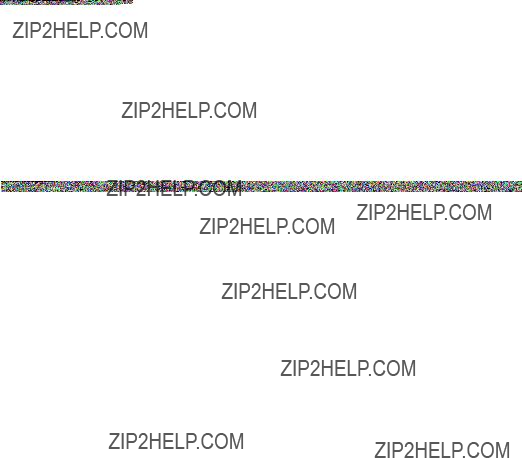
1. OPERATIONAL OVERVIEW
1.5Displays
1.5.1Choosing a display
Six display modes are available. Choose the display mode which matches your current needs.
1. Click Disp.
Disp menu
2. Click Mode.
Mode dialog box
3.In the Display Mode window choose the mode you wish to use. See the next several sections for display descriptions. To divide the screen, go to step 4. Otherwise go to step 5.
4.In the Screen Layout window, click the screen division you wish to use. The Preview window shows the results of your selection. Note that the
5.Click the OK button to finish.

1. OPERATIONAL OVERVIEW
1.5.2
The
Note: When the display range for the
Menu for turning deep mode
on or off
Deep mode 
Deep mode detection options

1. OPERATIONAL OVERVIEW
1.5.3
The
* Beam direction
B: Bearing (angle from bow direction)
T: Tilt angle (angle from downward direction)
Horizontal range from transducer
Dividing line
* Beam direction can be shown with an icon (  ). See paragraph 3.2.
). See paragraph 3.2.
Changing display area
The width of each display can be adjusted as follows:
1.Place the trackball pointer on a dividing line between displays, and the pointer changes to a 


 ).
).
2.Hold the left button while dragging the

1. OPERATIONAL OVERVIEW
Note: Normally, pulses are fired from beam 1, beam 2 and beam 3 in that order and displayed on the screen as the port, downward and starboard images. When the display range of the
Menu for turning simultaneous transmission on or off
Simul. TX
Simultaneous transmission options
1.5.4
The
0
Note: When the display range for the split beam + two beam presentation is 1000 m or higher, ???Deep Mode??? and ???Simul Tx??? appear in the menu bar. To enable the deep mode or simultaneous transmission, click the appropriate item on the menu bar followed by clicking ON.

1. OPERATIONAL OVERVIEW
Deep mode, Simul. TX
Menu bar
1.5.5User 1, User 2, User 3 display
These displays show the product of displays created with ???Display mode change??? button in the Mode window. The default settings are as follows:
User 1: Split beam display
User 2:
User 3: Split beam +
For how to customize the User displays see paragraph 3.1.

1. OPERATIONAL OVERVIEW
1.6Choosing a Display Range
Choose the detection range (from the transducer to the bottom), in 12 preset choices. The default ranges are shown in the table below.
Display ranges
Note: You may set ranges as desired. For further details, see Chapter 3.
1. Click Setting.
Setting menu
2. Click Echo image.
Echo image dialog box

1. OPERATIONAL OVERVIEW
3. Click ??? in the Range box.
Range options
4.Click the range you wish to use. For example, choosing ???80???, the display will show underwater conditions from the transducer down to 80 m.
5.Click the OK button.

1. OPERATIONAL OVERVIEW
1.7Shifting the Display Range
You may shift the display in order to look at a shallower or deeper depth without changing the current range.
Shift the start  depth to watch shallow or deep
depth to watch shallow or deep
Picture
Shift principle
1.Click Setting.
2.Click Echo image.
3.Click ??? or ??? in the Shift box to choose shift value.
4.Click the OK button.

1. OPERATIONAL OVERVIEW
1.8Adjusting the Gain
Adjust the gain according to signal strength. Adjust so noise just disappears from the screen.
 CAUTION
CAUTION
Use the proper gain setting.
Incorrect gain may produce wrong depth indication, possibly resulting in a dangerous situation.
1.Click Setting.
2.Click Echo image.
3.Click ??? or ??? in the Gain box to choose the gain setting desired.
Examples of gain settings and resulting pictures
4. Click the OK button.

1. OPERATIONAL OVERVIEW
1.9Find Depth and Position of a Fish Echo
You may measure the depth to a fish school or bottom with the horizontal line marker, called the horizontal VRM (Variable Range Marker) marker. Further, you may measure elapsed time with the vertical VRM. For example, you can measure how many minutes before the current time a fish echo appeared.
Elapsed time and postion* to vertical VRM
Horizontal VRM
Depth to horizontal VRM
* Position shown in red when position data is lost.
Measuring depth, elapsed time and position with the VRMs
Measuring depth
1.Roll the trackball to place the pointer on the horizontal VRM. The shape of the pointer changes to ( ).
).
2.Hold down the left button while rolling the trackball upward or downward to place the horizontal VRM on the object that you wish to measure the depth.
3.Read the depth indication (on the horizontal VRM).
Measuring elapsed time
1.Roll the trackball to place the pointer on the vertical VRM.
2.Hold down the left button while rolling the trackball leftward or rightward to place the VRM on the object that you wish to find position.
3.Read the elapsed time and position (on the vertical VRM).
Note 1: The color of the VRMs can be changed. See paragraph 3.5
Note 2: You may change the location of the depth indication on the horizontal VRM. For further details see paragraph 3.2.

1. OPERATIONAL OVERVIEW
1.10Inscribing Lines
You may inscribe vertical lines on the display to mark fish schools, shoals, etc.
When an echo of interest appears, click Marker line on the menu bar to inscribe a vertical line on the display. If TIMER is turned on in the Status window, elapsed time is counted from the moment the mark is inscribed.
Note that color of the marker line can be changed. For details, see paragraph 3.5.
1.11Fish Size Histogram
The fish size histogram display shows single fish size within the area measured. You may set up this display as follows:
1.Display the
2.Click Disp.
3.Click Display Window.
Display window dialog box
4.Click Fish size histogram. The toggle button is then colored in purple (ON state). Each click turns the display on or off alternately.
5.Click the OK button. The fish size histogram appears and measuring begins.

1. OPERATIONAL OVERVIEW
Fish size histogram window
Note 1: The fish size histogram window can be moved as desired. For details, see Chapter 2.
Note 2: When the fish size histogram window is closed, all data measured is deleted.
How to read the fish histogram
The bar graph shows size and proportion of fish in measuring area. The vertical axis shows fish length (default setting) and the horizontal axis shows distribution. In the fish size histogram display above, more than 50% of the fish in the measuring area are 10 cm in length.

1. OPERATIONAL OVERVIEW
1.12Setting Measuring Area
There are four ways to set the measurement area for the fish size histogram:
???Measure fish at specific location
???Measuring depth shallower than bottom in all directions
???Measure specific depth range
???Measure bottom fish
1.12.1Measuring fish in a specific location
1.Click Setting.
2.Click Fish size. Click the Fish size histogram tab if necessary to show the fish size dialog box.
Fish size dialog box, measurement
If the Unit or Display dialog box is shown, click the Measurement tab. 3. Click ??? in the Measuring area box.
Area options
4. Click Manual.

1. OPERATIONAL OVERVIEW
5.Click ??? or ??? in the Area Vertical box to set the vertical width of the area marker. (Setting range:
6.Click ??? or ??? in the Area Horizontal box to set the horizontal width of the area marker. (Setting range:
7.Click the OK button.
8.Use the trackball to place the pointer on the area marker (yellow frame). The shape of the pointer changes to ( ).
).
9.Hold down the left button while using the trackball to position the marker.
1.12.2Measuring fish in all areas
1.Click Setting.
2.Click Fish size.
3.Click ??? in the Measuring area box.
4.Click All.
5.Click the OK button.
1.12.3Measuring fish in a specific depth range
1.Click Setting.
2.Click Fish size.
3.Click ??? in the Measuring area box.
4.Click Specific range.
5.Click the OK button.
6.Use the trackball to place the pointer on the measurement area boundary line.
7.Hold down the left button while rolling the trackball upward or downward to position the boundary line where desired.
1.12.4Measuring bottom fish
1.Click Setting.
2.Click Fish size.
3.Click ??? in the Measuring area box.
4.Click Bottom trace.
5.Click ??? in the Bottom trace area box.
6.Click measurement range desired. The measurement range starts from the bottom.
7.Click the OK button Measurement range markers (1) and (2) appear as in the figure at the top of the next page.
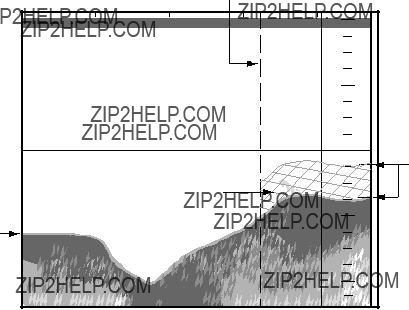
1. OPERATIONAL OVERVIEW
Measurement range marker(2)
 ashed yellow vertical line)
ashed yellow vertical line)
Measurement range markers on the fish size display
8.Place the cursor on the measurement range marker(2) (yellow vertical line). The shape of the cursor changes from an arrow ( ) to
) to  )
)
9.Using the left button, drag the measurement range marker(2) to the location desired and the release the left button. Measurement range marker(1) (short yellow horizontal dash) automatically traces the bottom.
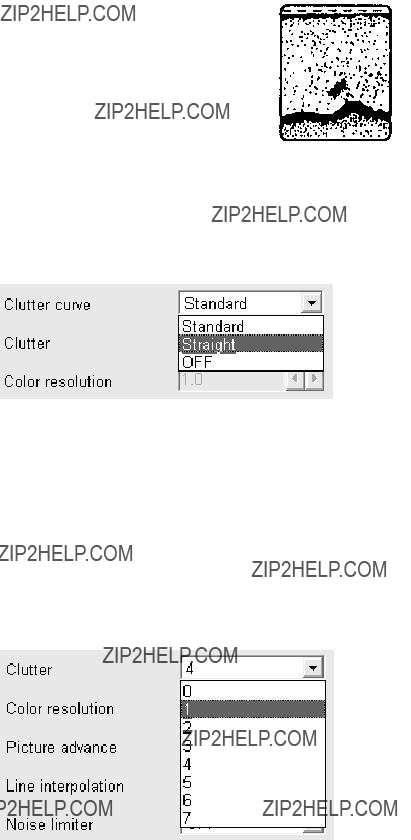
1. OPERATIONAL OVERVIEW
1.13Suppressing Low Level Noise (Clutter suppression)
Appearance of clutter on the display
1.Click Settings.
2.Click Echo image.
3.Click ??? in the Clutter curve box.
Clutter curve options
4. Click the setting desired, referring to the description below.
Standard: With ???high??? clutter level setting, strong colors are untouched while weak echo colors are suppressed.
Straight: With ???high??? clutter level setting,
OFF: Clutter suppression function is disabled. 5. Click ??? in the Clutter box.
Clutter options
6.Click the setting desired.
7.Click the OK button.

1. OPERATIONAL OVERVIEW
1.14Eliminating Weak Echoes
Sedimented water or reflections from plankton may be painted on the display in green or
1.Click Settings.
2.Click Echo image.
3.Click ??? or ??? in the Signal level box to choose the echo strength you wish to erase. The higher the number the stronger the echo that will be erased.
4.Click OK button.
1.15Suppressing Unwanted Noise
Noise from other echo sounder or electrical interference may show itself on the screen. Use the noise limiter to suppress unwanted noise.
Examples of noise
1.Click Setting.
2.Click Echo image.
3.Click ??? in the Noise limiter box.
Noise limiter options
4.Click the setting desired. The higher the number the greater the degree of suppression. Choose OFF when no noise exists, so as not to miss small targets.
5.Click the OK button.
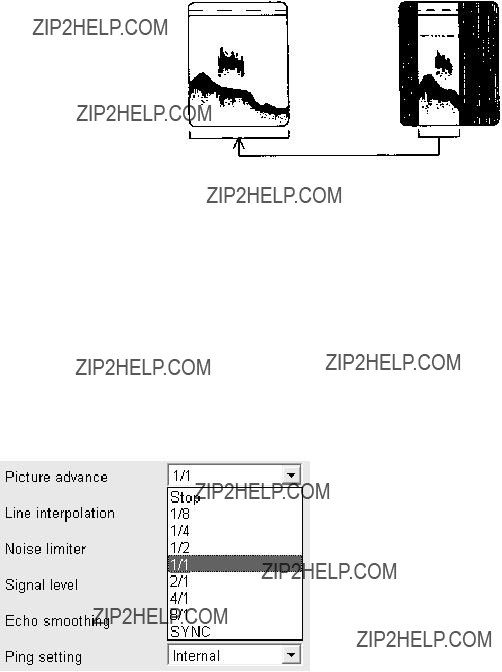
1. OPERATIONAL OVERVIEW
1.16Picture Advance Speed
The picture advance speed determines how quickly the vertical scan lines run across the screen. When selecting a picture advance speed, keep in mind that a fast advance speed will expand the size of the fish school horizontally on the screen and a slow advance speed will contract it.
The advancement speed may be set independent of or synchronized with ship???s speed.
1.Click Settings.
2.Click Echo image.
3.Click ??? in the Picture advance box. The fractions in the window denote the number of scan lines produced per transmission. For example, 1/8 means one scan line is produced every eight transmissions. STOP freezes the display and it is convenient for observing an echo. SYNC advances the picture according to ship???s speed. See the next page.
Picture advance options
4.Click the setting desired.
5.Click the OK button.
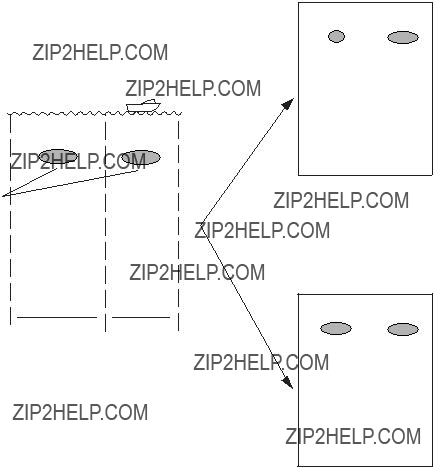
1. OPERATIONAL OVERVIEW
Ship???s speed dependent picture advance
With speed data provided by a
Note: This feature is available with ship???s speed between 2 and 20 kts. If ship???s speed is above or below those values, the picture is advanced using the upper or lower limit whichever is closest to the actual ship???s speed.
Fish school shrinks as speed is increased; expanded
as speed is decreased.
Same size fish schools
FULL??? HALF???
Speed  SPEED
SPEED  SPEED
SPEED 
Actual Movement
Normal Mode
Fish schools are shown same size regardless of ship???s speed.
How the ship???s speed dependent picture advance mode works

1. OPERATIONAL OVERVIEW
1.17
The
1.Click Disp.
2.Click Mode.
3.Use the trackball to choose the desired
Small:
Standard:
Large:
To turn off the
1. OPERATIONAL OVERVIEW
1.18Alarms
This sounder has four alarms: bottom alarm, bottom fish alarm, water temperature alarm and vertical temperature alarm. When the bottom echo or fish echo comes into the alarm range or the water temperature is within or out of the range of the temperature value set, the equipment generates audio and visual alarms to alert you. If ???Alarm??? is enabled on the Status window, the offending is shown in red, in reverse video. To silence the audio alarm, press any function key. The audio and video alarms will be released anytime the alarm conditions are violated.
1.18.1Alarm description
Bottom alarm
The bottom alarm alerts you when the bottom echo enters the alarm area. The audio alarm sounds and the visual alarm ???BOTTOM??? appears in red reverse video and flashes when the bottom alarm is violated.
Fish alarm
The fish alarm alerts you when fish echoes enter into the set alarm range. The audio alarm sounds and the visual alarm ???FISH??? appears in red reverse video and flashes when the bottom alarm is violated. This alarm is useful when targeting a specific fish specie, since each fish specie is known to inhabit certain depths.
Bottom fish alarm
The
Temp alarm (requires temperature sensor)
There are two types of temperature alarms: within range and out of range. The audio alarm sounds and the visual alarm ???TEMP??? appears in red reverse video and flashes when the temperature alarm is violated. The temperature alarm may be used to target specific fish species, as each fish specie is know to inhabit certain temperature ranges.
There are two types of

1. OPERATIONAL OVERVIEW
1.18.2Enabling, disabling an alarm
1.Click Settings.
2.Click Alarm.
Alarm dialog box
3.Check the box in Bottom alarm, Fish alarm, Temp alarm or
4.For the Fish alarm, choose alarm type with the radio buttons Fish or Bottom fish.
For the temp alarm or
5.Click ??? or ??? in the Alarm depth box (for bottom alarm or fish alarm) or Temp limit box (for temperature alarm or
6.Click ??? or ??? in the Alarm zone box to set the width of the alarm from the starting point.

1. OPERATIONAL OVERVIEW
7. Click the OK button.
 Starting point
Starting point
 Alarm marker
Alarm marker
Green: Bottom alarm
Orange: Fish alarm, Bottom fish alarm
Purple: Temperature alarm (Temperature graph turned on from DIsplay item dialog box)
Alarm marker
The alarm marker appears at the right edge of the display, and the color is green for the bottom fish alarm and orange for the fish alarm.
To disable an alarm, remove the check mark from the box at step 3 in the above procedure.
1.18.3Setting audio alarm volume
You may set the volume of the audio alarm as follows:
1.Click Settings.
2.Click Alarm.
3.Click ??? in the Volume box.
4.Click the setting desired. (setting range:
5.Click the OK button.

1. OPERATIONAL OVERVIEW
1.19Function Keys
The function keys on the control unit provide for
1.19.1Using the function keys
The default program for each function key is as shown in the table below. Press the appropriate function to access the setting window programmed for it.
1.19.2Programming the function keys
1.Press the appropriate function key until the menu title looks something like the one shown below.
Pressed function key
File Disp Setting System Window
2.Click the item on the menu bar which you want to use. For example, ???Alarm??? in the Setting menu. Note that neither ???Load user setting??? nor ???Save user setting??? (in the File menu) can be used.)
Confirmation
Assign the [ Alarm...] menu to the [F1] key?
3.Click the Yes button. The item selected at step 2 appears.
4.Click the OK button.

1. OPERATIONAL OVERVIEW
1.20Saving, Recalling User Settings
You may save echo sounder settings, and recall them when desired. This is useful when you want to set up the equipment quickly for a specific objective; for example, certain fish species.
1.20.1Saving user settings
1.Adjust settings according to targeted fish or objective.
2.Click File.
3.Click Save user setting.
Selected (dark blue)
Save area
Scroll bar
Save user setting
4.Click the ??? or ??? button to choose an empty save area. The chosen save area is highlighted in dark blue. You also may the scroll bar to choose a save.
Note: If 20 areas are already saved, choose an unnecessary one to write over it. 5. Click the Save button.

1. OPERATIONAL OVERVIEW
1.20.2Loading user settings
Note that you cannot load user settings while transmitting.
1.Click File.
2.Click Load user setting.
This window  shows chosen
shows chosen
display settings
Thumbnail of display settings
Read display
3.Click the ??? or ??? button to choose the display settings you wish to display. The chosen display setting is highlighted in dark blue.

1. OPERATIONAL OVERVIEW
Note: You may use the Details button to display detailed information about the chosen display settings.
Asterisk indicates saved display settings
This window  shows display settings in detail
shows display settings in detail
Details button
Read display, details shown
4. Click the Read button to activate chosen settings.

1. OPERATIONAL OVERVIEW
1.21Recording, Replaying Data
The USB port on the processor unit connects to a USB 2.0 hard disk (user supplied) to record and replay raw data and picture data.
Connecting a hard disk
1.21.1Choosing where to record data
1.Connect a USB hard disk to the USB port on the processor unit.
2.Click Setting.
3.Click Record.
Not displayed during TX or RX.
Record dialog box

1. OPERATIONAL OVERVIEW
4. Click the Reference button.
Volume (E):
5.Choose location of data recording and then close the Reference window.
6.Click ??? or ??? successively in the Recording time box to set recording time
7.Click ??? or ??? successively in the Recording free space box to set required free space
8.Click the OK button.
Data recording information
Data recording information can be confirmed in the Record info sub window. In ???Data view??? in the Record info sub window, choose file to find its size or recording time by clicking its check box to show the check mark (9). The size or recording time for the file selected appears in the Disk space info sub window. To change the display content, click Time or Size at ???Unit??? in the Disk space info sub window.
Deleting recorded data
Data can be deleted from the Record window as follows:
1.In the Data view sub window, check the data you wish to delete. To delete all files, click the Select all button. To deselect all files, click the Release all button.
2.Click the Delete button. A confirmation window asks if it is OK to delete files.
3.Click the Yes button.
4.Click the Yes button. The bar at the bottom of the window now reads ???100%???.

1. OPERATIONAL OVERVIEW
1.21.2Recording data
1. Connect a USB hard disk to the USB port on the processor unit. 3. Click File.
File menu
3. Click Record.
When a file is recorded it is automatically assigned a file name comprised of date and time of the recording plus the extension .lst. An example file name is shown below.
2005_03_01_05_50_32.lst
Extension
Seconds
Minutes
Hours
Day
Month
Year
To stop recording data, choose Stop at step 3 in the above procedure.

1. OPERATIONAL OVERVIEW
1.21.3Converting recorded data to HAC format
Recorded data can be converted to HAC format data, the standard archiving and playback format for fisheries acoustics data. This HAC format is nonrestrictive and independent of the computer platform. It can accommodate most echo sounders. Note that this feature is not available when transmitting or receiving.
1.Connect USB hard disk to the USB port on the processor unit.
2.Click File.
3.Click TX Stop.
4.Click File.
5.Click Convert to HAC format.
Convert to HAC format dialog box
6.Click the Reference button
7.Choose the file (LST file) you wish to convert.
8.Click the Open button.
Total no. of pings in .lst file
C:\Documents and Settings\FCV30\2005_03_01_05_50_32..hac
Location of
HAC file

1. OPERATIONAL OVERVIEW
9.With the slider bars, choose start position and end position.
10.Click the Start button to start the conversion. The progress bar extends rightward as the conversion progresses. When the conversion has been completed the message ???End of conversion??? appears. Click the OK button to finish.
11.Click the Close button.
1.21.4Playing back data
1.Connect a USB hard disk to the USB port on the processor unit.
2.Click File.
3.Click TX Stop.
4.Click Play.
File location box
Open
E: Removable disk
File  box
box
Choosing file to replay
5.Click ??? in the file location box.
6.Click the hard disk drive connected to the
7.
8.
9.
10.Click an LST file to show file name in reverse video. Chosen LST file appears in the file box.
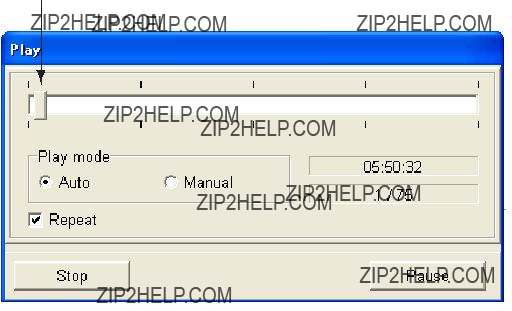
1. OPERATIONAL OVERVIEW
11. Click the Open button to start playback.
Sliding bar
Check to  repeat playback.
repeat playback.
Play dialog box
Notes on playing back data
???Use the Play Mode Manual and Play Mode Auto radio buttons to change setting data: Auto: Use settings used at the time of the recording.
Manual: Apply current settings.
???To playback a file manually, use the sliding bar to choose the location where to start playback and then hit the Restart button.
???Click the Pause button to temporarily stop playback. To restart playback use the Restart button.
???Use the Stop button to stop playback.
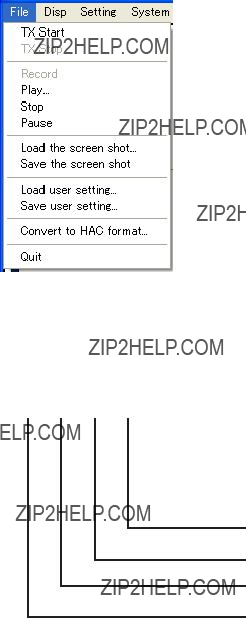
1. OPERATIONAL OVERVIEW
1.21.5Saving screen shot
You may take a screen shot to save the current window. Compared to raw data, the size of the screen shot is small, thus loading time is much shorter.
1.Connect a USB hard disk to the USB on the processor unit.
2.Click File.
3. Click Save the screen shot.
The screen shot is saved to the location designated at step 5 in paragraph 1.21.1. This data is automatically assigned a file name and extension as below.
05_50_32.jpg
Extension
Seconds
Minutes
Hours
File name for screen shot

1. OPERATIONAL OVERVIEW
1.21.6Loading a screen shot
1.Connect hard drive to the USB on the processor unit.
2.Click File.
3.Click Load the screen shot.
File location box
Open
E: Removable disk
2006_04_10
File  box
box
Image(*.jpg)
4.Click ??? in the file location box.
5.Click the hard disk drive connected to the
6.
7.
8.
9.Click a JPG file to show file name in reverse video. Chosen JPG file appears in the file box.
10.Click the Open button to load the screen shot.

1. OPERATIONAL OVERVIEW
11. To erase the screen shot. click the Close button.
1. OPERATIONAL OVERVIEW
This page intentionally left blank.

2.WINDOW DISPLAYS
The
You may locate these windows anywhere on the screen. Further, right clicking at the upper right side of a window displays associated
2.1Turning on Window Displays
1. Click Disp.
Disp menu
2. Click Display Window.
One zoom window may be enabled.
Display window dialog box
3.Choose item(s) to enable or disable in the Display item window and then push the left button. Items which are enabled are highlighted in blue and those which are disabled are grey.
Note: Only one among bottom lock, bottom zoom and marker zoom may be enabled.
4.To change size of bottom lock, bottom zoom and marker zoom windows, click appropriate radio button in the Zoom window size window.
5.Click the OK button.

2. WINDOW DISPLAYS
Automatically arranging windows
1. Click Window on the menu bar.
Window currently displayed. (Click to bring window to front.)
2. Click Auto arrange to relocate windows to their default locations.
Moving windows
1.Use the trackball to place the pointer in the window.
2.Roll the trackball while holding down the left button to move the window.
2. WINDOW DISPLAYS
2.2Interpreting the Window Displays
2.2.1Status window
The Status window shows current settings and data input from external sensors. You may choose the items to display in the Status window by selecting them from the status setting window. Depth is indicated at the lower
Status windows (Top: Enabled with Status in Display Window, Bottom: Fixed at screen bottom)
How to setup the Status window
1.Click Settings.
2.Click Status.
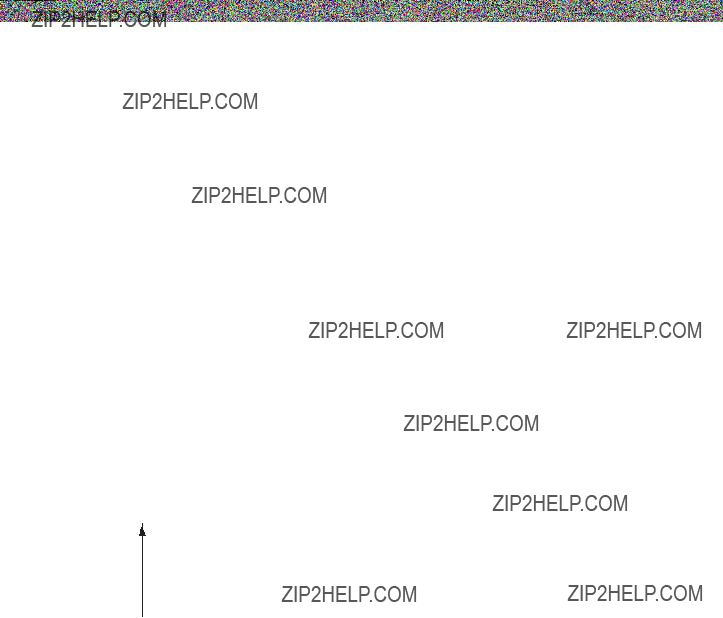
2. WINDOW DISPLAYS
This window shows which indications are currently displayed.
Status dialog box
3.Click items in the Display Item window as appropriate. Enabled items are highlighted in blue.
Note 1: ???Default??? restores default Status window items; ???Select all??? enables all items; Release all disables all items.
Note 2: You may change the location of items in the Status window freely:
1)Click the item in the Layout window which you want to change its location.
2)Click the box in the Layout window which corresponds to the location where you want to location the item clicked at step 1.
4.To change the transparency of the Status window, choose Opaque or Transparent from ???Window???.
5.To choose Status window type, choose Window or Fixed at bottom in the Display window. Choose Window to get a moveable window, or Fixed at bottom to anchor the Status display at the bottom of the screen.
6.To choose the size of the characters for the Status window, click Small, Standard or Large in the Font size window.
7.To display the draft indication, click ON in the Draft indication window.
8.After setting up the Status window, click the OK button.
2. WINDOW DISPLAYS

2. WINDOW DISPLAYS
2.2.2Fish size histogram window
The fish size histogram shows fish size within the selected measuring area. The SPLIT (split beam) display must be active to show the fish size histogram window.
Number of fish within vertical axis
Vertical range
Unit of  measurement
measurement
Number of fish
within measuring area
 Horizontal axis
Horizontal axis
Fish size histogram window
Setting up the fish size histogram dialog box
1.Click Setting.
2.Click Fish size.
Fish size histogram dialog box
2. WINDOW DISPLAYS
Note: If the Target graph dialog box appears, click the Fish size histogram tab.

2. WINDOW DISPLAYS
2.2.3Target graph window
The target graph window plots fish echo position (latest three scans). It is available when the SPLIT display is active.
Target graph
Own ship
 Radius scale
Radius scale
Latest three data are shown.
Color of circle indicates strength of individual fish echo.  (Large circle): latest data
(Large circle): latest data
(Medium circle): 2nd latest data
(Small circle): 3rd latest data
Target graph window
Setting up the target graph window
1.Click Setting.
2.Click Fish size. If the Fish size histogram dialog box is shown, click the Target graph tab to show the Target graph dialog box.

2. WINDOW DISPLAYS
Fish size dialog box, Display tab
Note 1: If the Measurement or Unit dialog box appears, click the Display tab to open the Display dialog box.
Note 2: ???Radius scale??? sets the width of the area in degrees

2. WINDOW DISPLAYS
2.2.4
The
Horizontal axis  (depth)
(depth)
Horizontal axis (temperature)

2. WINDOW DISPLAYS
Setting up the
1.Click System.
2.Click Net.
Input data: Choose the format of data fed from net sonde or trawl sonar. CIF: Water temperature and net depth fed from net sonde. NMEA: Water temperature and net depth fed from trawl sonar
Horizontal axis Min and Horizontal axis Max: These set the minimum and maximum temperature scale, and the range is
2.2.5
The

2. WINDOW DISPLAYS
Setting bottom lock zoom range
1.Click Setting.
2.Click Echo image.
3.Click ??? in the Zoom range box and push the left button.
Zoom range options
4.Click the setting you wish to use.
5.Click the OK button.
2.2.6Bottom zoom window
The bottom zoom window expands bottom and bottom fish echoes by the zoom range selected. It is useful for determining bottom hardness. A bottom displayed with a short echo tail usually means it is a soft, sandy bottom. A long echo tail means a hard bottom.
Bottom zoom window

2. WINDOW DISPLAYS
2.2.7Marker zoom window
The marker zoom window zooms echoes within the expansion marker (blue dashed line). This marker is operated the same as the horizontal VRM.
Marker zoom window
Note: When the divided screen is in use, click the Marker change button to shift the expansion marker between beams.

2. WINDOW DISPLAYS
2.2.8Bottom discrimination graph window
The bottom discrimination graph plots bottom nature, and it can be plotted on the bottom zoom, bottom lock and zoom marker windows. Right click one of those windows to show a
Hardness: Plots bottom hardness. ???H??? appears at the left side of the window when the Hardness feature is active.
Roughness: Plots bottom roughness. ???R??? appears at the left side of the window when the Roughness feature is active.
The higher the figure, the harder or more uneven the bottom.
The color of the graph may be chosen from the Color dialog box. The icon color indicates color of respective graph.
Bottom discrimination (hardness)
Bottom discrimination (roughness)
Bottom discrimination graph

3.CHANGING SETTINGS
This chapter provides the information necessary for changing equipment settings. For details about specific dialog boxes, see the table below.
3.1Mode Dialog Box
The Mode dialog box lets you choose an
1.Click Disp.
2.Click Mode.
Mode dialog box
3. In the Display Mode window, enable User1, User2 or User3 as appropriate.
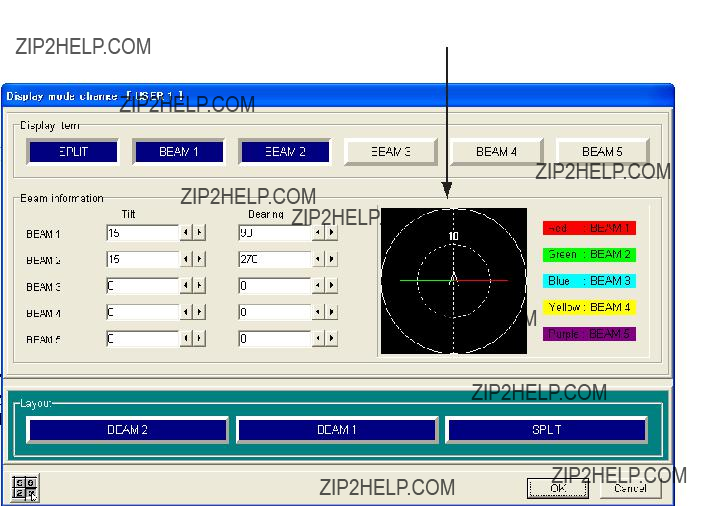
3.CHANGING SETTINGS
4.Click the Display mode change button.
Shows direction of detection beam.
Display mode change dialog box
5.In the Display Item window,
6.Click ??? or ??? successively in a Tilt box to set tilt angle
7.Click ??? or ??? successively in a Bearing box to set bearing
8.Repeat steps 6 and 7 to set tilt and bearing for other beams.
9.You can change the location of a display screen as follows:
a)In the Layout window,
b)
10.Click the OK button to close the display mode change dialog box.
11.If you want to change screen layout format, choose Vertical, Horizontal or Combination from the Screen layout window.
12.To choose the size of the
13.Click the OK button.

3. CHANGING SETTINGS
3.2Display Item Dialog Box
The Display Item dialog box lets you choose what indications to display.
1.Click Disp.
2.Click Display Item.
Display item dialog box
3.In the Display Item window,
4.Click the OK button.
Display item dialog box description
Normal display: Choose items to show or hide:
Zoom display: (bottom discrimination graph): Show Hardness and/or Roughness of bottom on bottom discrimination graph. Bottom zoom, Bottom lock or Marker zoom must be active.
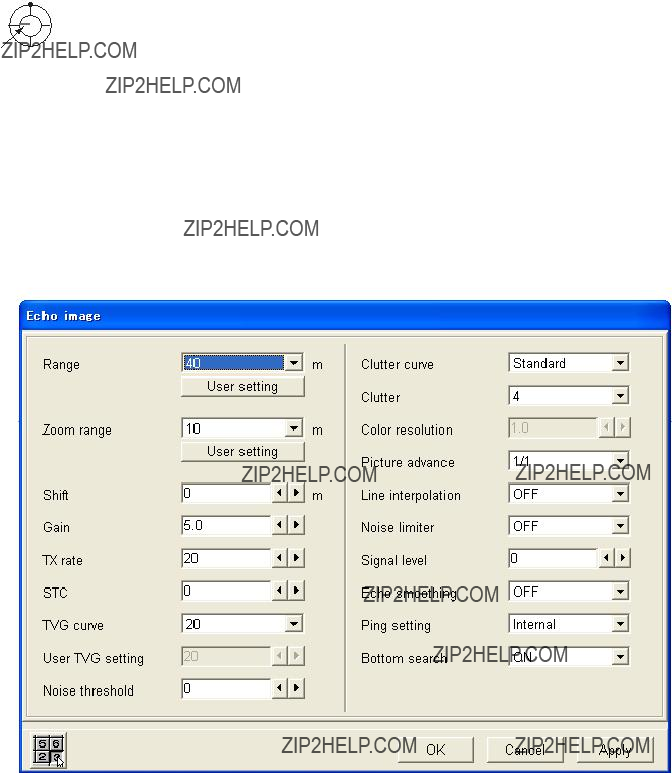
3. CHANGING SETTINGS
Temp graph scale: Choose where to display the temperature graph scale: Left,
Bottom discrimination scale: Choose where to display the bottom discrimination scale: Left,
Beam direction: Choose how to show beam direction: Letters, Figures or Letters + Figures.
Line length: Shows default angle.
10 deg: Radius of inner circle
20 deg: Radius of outer circle Line direction: Shows bearing.
3.3Echo Image Dialog Box
The Echo Image dialog box provides for control of echo sounder functions.
1.Click Setting.
2.Click Echo image.
Echo image dialog box

3. CHANGING SETTINGS
User ranges
If the
1. Click the User Setting button below the Range box or Zoom range box.
User range dialog boxes
2. Click ??? or ??? successively in the appropriate Range box to set range.
Note: To restore
3. Click the OK button.
Echo image dialog box description
TX rate: 20 TX rates are available. Normally, the highest rate (20) is used. When in shallow waters second reflection echoes may appear between surface and actual bottom echo. In this case, lower the rate.
STC: STC is useful for suppressing surface noise (plankton or bubble, etc.) The setting range is
TVG curve: Choose the TVG curve to use. The higher the numeric the higher the gain with depth.
User TVG setting: Effective when ???TVG curve??? is set for Manual. This allows you to set a different TVG from those provided.
Noise threshold: Adjusts noise present on long range (deep depth). The larger the figure, the more noise is erased.

3. CHANGING SETTINGS
Color resolution: Effective when ???Clutter curve??? is turned off. You may set display width dB for colors. Set display width dB for one color.
Line interpolation: Smoothes picture when picture advance speed is 2/1, 4/1 or 8/1.
Echo smoothing: When echoes look ???spotty???, adjust this setting. The higher the setting the greater the smoothing.
Ping setting: Chooses source of keying pulse, external (for use only when external echo sounder is used) or internal.
Bottom search: Turns bottom detection feature on or off. When turned off,
3.4Multi beam Dialog Box
This Multi beam dialog box sets up the
1.Click Setting.
2.Click Multi beam.
Multi beam dialog box
Multi beam dialog box description
TX frequency: Sets Tx frequency, and the choices are Low, Standard and High. For normal use, choose Standard. When interference exists because your vessel is near another vessel whose echo sounder operates on the same frequency as the
TX pulse width: Pulse width is automatically changed with display range and shift. A shorter pulse offers better resolution, while a longer pulse is useful for

3. CHANGING SETTINGS
Depth/Distance: This function compensates for depth difference between the picture from the downward beam and other that from other directions when the sonar beam is oriented in a direction other than downward.
Depth: Compensation applied (range scale shows depth)
Distance: No compensation (range scale shows distance from transducer)
TX power: Sets output power. The higher the number the greater the output power.
Simul. TX start Rng: Sets start range for simultaneous transmission. The setting range is
3.5Temp Dialog Box
The temp dialog box sets up temperature data (fed from temperature sensor). With connection of a temperature sensor, temperature change over time can be plotted on a graph.
1.Click System in the menu bar.
2.Click Temp.
Temp dialog box description
Temp input: Choose the data format of temperature data.
CIF: Temperature data fed from net sonde
NMEA: Temperature data fed from navigation equipment.
Temp adjust: An offset may be applied CIF temperature data to correct it.
Offset range:

3. CHANGING SETTINGS
3.6Color Dialog Box
The Color dialog box lets you set the colors to use.
1.Click System.
2.Click Color.
Color dialog box
Day/Night
Chooses window background color. Daytime color provides a white background; Nighttime color a black background.
Hue
You may adjust colors to meet various operating environments. User1 and User2 let you
1.Choose User1 or User2 as appropriate.
2.Click the Change button corresponding to the color you want to adjust.

3. CHANGING SETTINGS
Color
Basic colors:
Custom colors
Define Custom Colors >>
OK Cancel
Standard color choices
3.Choose a color from the Basic colors. If the color is suitable to you, go to step 7. To further customize the color, go to the next step.
4.Click the Define Custom Colors button.
Place pointer here.
Color
Custom colors
5.Place the pointer on the arrow at
6.Hold down the left button while dragging the arrow to choose color desired.
7.Click the OK button. The window closes and the color selected at step 2 is changed.
Note: To restore all default colors for a User color set, click the Default button. 8. Click the OK button.
Marker line: Choose color of marker line. The procedure is the same as for ???Hue???.
VRM: Choose the color of the VRM.

3. CHANGING SETTINGS
Temp graph: Choose the color of the graph line in temperature graph.
Bottom discrimination: Choose the color of the graph line in bottom discrimination graph.
Net: Choose the color of the color of each net sonde or trawl sonar marker.
Pane: Choose the color of the border around windows.
3.7Unit Dialog Box
The Unit dialog box lets you choose various units of measurement.
1.Click System on the menu.
2.Click Unit.
Unit dialog box
Unit dialog box description
Depth: Choose unit of depth measurement from among meters, feet, fathoms, hiro, and passi/braza.
Temperature: Choose unit of temperature measurement between ??C and ??F.
Speed: Choose unit of speed measurement among knots, km/h and mph.
Bearing: Choose bearing format between True and Magnetic.

3. CHANGING SETTINGS
3.8 Target Sphere Calibration Dialog Box
To accurately analyze fish distribution, it is necessary to calibrate target strength using a calibration sphere. The calibration is done to jibe the target strength (TS) value displayed in the fish histogram dialog box with the TS of the calibration sphere.
Follow the procedure below to perform the calibration.
1.Suspend a calibration sphere at least 3 m directly below the transducer.
2.Open the fish histogram dialog box.
3.While observing the echo sounder image, adjust the area marker (yellow rectangle) to place the echo of the calibration sphere within the area marker. (See paragraph 1.12.1 for details.)
Set the marker at the right edge of the screen in order to measure with most recent data. It is recommended to make the measuring area as small as possible to keep unwanted echoes out of the measuring area, however the calibration can be performed with any size measuring area.
4.Note the TS value in the fish histogram dialog box.
There is no problem if the TS value and the TS value of the calibration sphere do not agree. Ideally, it is desirable if the distribution graph in the fish histogram window shows only one bar for the calibration sphere, however the calibration can be executed regardless of distribution.
5.Confirm that the echo from the calibration sphere appears in the area marker in consecutive scans.
6.Click System on the menu bar.
7.Click Test/Initialization.

3. CHANGING SETTINGS
8. Click Target sphere calibration.
9.In the Target sphere TS box, use ??? or ??? to set the TS value (fixed value) of the target sphere.
10.Click the Start measurement button.
The TS value of the calibration sphere inside the area marker is calculated and is displayed in the Setting value box.
11.If necessary you may fine tune the found value.
12.Click the OK button to finish.

3. CHANGING SETTINGS
3.9External Echo Sounder
This equipment can show the image from the FURUNO echo sounder
3.9.1Displaying image from external echo sounder
1.Click File on the menu bar.
2.Click ETR. The
*HF: High frequency
LF: Low frequency
B/L: Bottom lock
B/Z: Bottom zoom
M/Z: Zoom marker
Note: A
See the next several paragraphs for menus available with the external echo sounder display.

3. CHANGING SETTINGS
3.9.2File menu
Click File on the external echo sounder window???s menu bar.
Load user setting: Recall saved user settings.
Save user settings: Three sets of user settings can be saved. For further details, see paragraph 1.20.1.
Close: Stop Tx/Rx by

3. CHANGING SETTINGS
3.9.3Display menu
Click Display on the external echo sounder window???s menu bar.
ETR setting window
Display mode: Choose display mode among High
Zoom mode: Choose the zoom mode among Bottom lock, Bottom zoom and Marker zoom. The display mode must be high frequency zoom or low frequency zoom, otherwise this feature is inoperative.
Screen layout: Show the external echo sounder image in horizontal or vertical split. The low

3. CHANGING SETTINGS
ETR display item dialog box
Show or hide Color bar, Time marker, Mode indicator,
Display item: Choose to display or hide color bar, time marker, mode indicator, horizontal VRM, vertical VRM and depth.
Display size: The size of the external echo sounder window may be set to small, medium or large.

3. CHANGING SETTINGS
3.9.4Setting menu
1.Click Setting on the echo sounder window???s menu bar.
2.Click Echo image.
Range: Choose display range among eight ranges. Display range is automatically chosen when the Auto mode (Fishing or Cruising) is active.
Shift: Set amount of display range shift.
Gain: Set gain. Gain is automatically chosen when the Auto mode (Fishing or Cruising) is active.
TVG level: Compensate for propagation attenuation of the ultrasonic waves. It does this by equalizing echo presentation so that fish schools of the same size appear in the same density in both shallow and deep waters. The higher the figure, the lower the gain on near range.
TVG distance: Set effective range of TVG.
Bottom level: If the depth indication is unstable in automatic or manual gain adjustment, adjust bottom level to get stable depth indication.
3. CHANGING SETTINGS
STC: Help distinguish surface fish from surface echoes. The setting range is
Range details: If the
Zoom range: Set zoom ranges.
Zoom range details: f the
Clutter: Adjust to suppress
Picture advance: Choose the speed of picture advancement.
Noise limiter: Turn on to reject noise. The settings are OFF, NL1, NL2 and NL3, and NL3 provides the highest degree of noise suppression.
Echo smoothing: Adjust this item when echoes appear ???spotty???. The higher the setting the greater the smoothing.
Signal level: Sedimented water or reflections from plankton may be painted on the display in green or
Tx rate: Choose the interval between transmissions. The smaller the figure the longer the time between transmissions and thus the longer an image remains on the screen.
Ping setting: Interference from another echo sounder or a scanning sonar may be suppressed by synchronizing transmission with the offending echo sounder or scanning sonar. Choose External to synchronize transmission. Select Internal when no echo sounder or scanning sonar is connected, or to synchronize and transmit with the TX signal from this equipment.
Auto mode: Turn the auto mode ON or OFF. When activated display range, gain and clutter are automatically adjusted, for virtually
Display range: Adjusted to display bottom echo on the screen.
Gain: Adjusted to display the bottom echo in
Clutter: Adjusted to suppress weak echoes (such as those from sedimented water).
Two auto modes are available: Cruising and Fishing. ???Cruising??? suppresses weak echoes to show the bottom echo clearly. ???Fishing??? displays weak echoes clearly.
Target echo: The default setting is ???Standard???, which is useful for general fishing. If the objective is whitebait, choose ???Surface???.

3. CHANGING SETTINGS
3.9.5System menu
1.Click Setting on the menu bar
2.Click System.
ETR TX/RX dialog box
Click TX/RX on the System menu to show this dialog box.
Gain adjustment: Compensate for too high or too low gain and adjust gain balance of low
and high frequency. Setting range:
Freq adjustment: Fine tune the Tx frequency when interference cannot be rejected
otherwise. Setting range:
TX power reduction: This setting is normally ???OFF???. However, if an echo sounder of the same frequency as your own is being operated nearby, interference may appear on your display. In this case, both parties should lower their TX power to remove the interference. Turn this item ON to lower TX power.
Tx pulse length: Pulse length is automatically selected according to display range and display shift settings. For manual selection, choose a short pulse when resolution is important and choose a long pulse when
Short1: Detection resolution is improved, however detection range is shorter (1/4 of standard) compared to Short2.
Short2: Detection resolution is improved, however detection range is shorter (1/2 of standard).
Standard: Use for general fishing operations.
Long: Detection resolution is lower, however detection range is longer (2x normal). Depending on the range, the Tx rate is 1/2 of the normal.
Manual: Operator chooses pulse length.

3. CHANGING SETTINGS
Tx pulse length (Manual): Operative when TX pulse length is set to Manual. The pulse length range is
ETR Compensation dialog box
Draft: To get depth from the sea surface (rather than the transducer), enter ship???s draft.
Setting range:
Sound velocity: Adjust the sound velocity of the Tx pulse if the depth indication is incorrect.
Setting range:
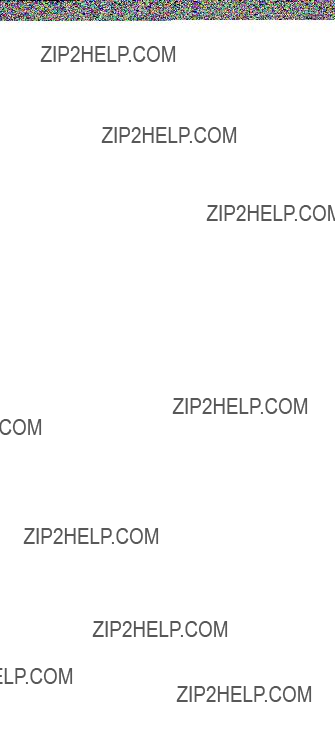
3. CHANGING SETTINGS
ETR Color dialog box
Day/Night: Choose background color of the echo sounder window. Choose ???Day??? for white background; ???Night??? for black background.
Hue: Choose color arrangement for the echo sounder image. The procedure is the same as that shown in paragraph 3.6.
VRM: Choose color for the horizontal and vertical VRMs.
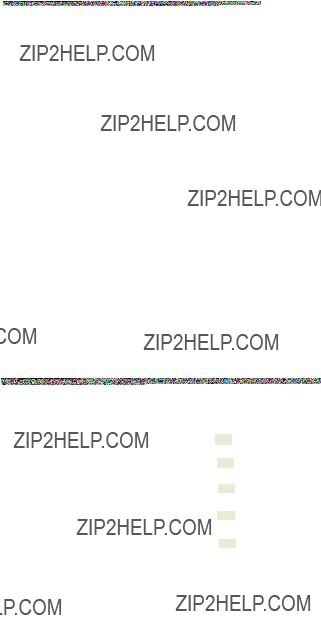
3. CHANGING SETTINGS
Unit menu
Choose unit of depth measurement.
Test/Initialization menu
Simulation: The simulation mode provides simulated echo sounder operation to help acquaint with the features of this equipment, without the need for connecting the transducer. The echo sounder image stored in the memory is played back on the echo sounder window. ???Demo??? appears on the title bar of the echo sounder window when the simulation mode is active.
Self test: Display the program no. of the
OK
OK
OK
OK
Default setting: Restore the
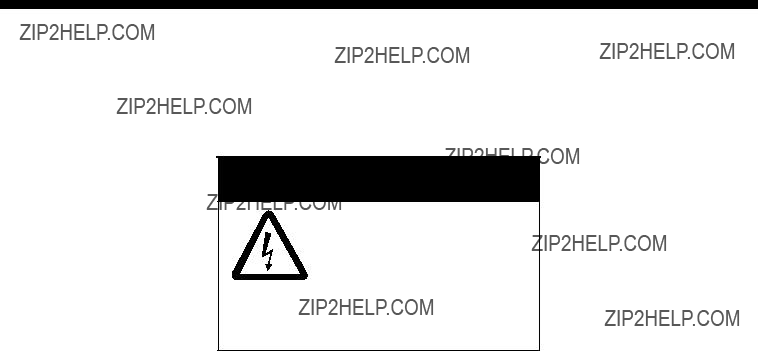
4.MAINTENANCE &
TROUBLESHOOTING
4.1Maintenance
Regular maintenance is important for maintaining good performance. Follow the recommended procedures to keep the equipment in good working order.
 WARNING
WARNING
Do not open the equipment.
Hazardous voltage which can cause electrical shock exists inside the equipment. Only qualified personnel should work inside the equipment.
4.1.1Check points
The items to check on a regular basis are tabulated below.
4.1.2Cleaning
Dust on the equipment should be removed with a soft, dry cloth. For stubborn dirt,

4. MAINTENANCE & TROUBLESHOOTING
4.1.3Replacing fuses
Fuses protect the processor unit and transceiver unit from overvoltage and internal fault. If a fuse blows find the cause before replacing it. If it blows again after replacement, request service.
 WARNING
WARNING
Use the proper fuse.
Use of a wrong fuse can result in damage to the equipment or cause fire.
4.1.4Transducer
Remove marine life and growth from the transducer face, using a piece of wood. DO NOT paint the transducer face. Handle the transducer carefully.

4. MAINTENANCE & TROUBLESHOOTING
4.1.5Trackball
If the trackball does not roll smoothly it may require cleaning. Do the following to clean the trackball.
1. Turn the ring on the trackball 45??.
Trackball
Ring
Trackball
2.Clean the ball with a soft
3.Look for a
4.Make sure that fluff from the swab is not left on the rollers.
5.Replace the ball and retainer ring. Be sure the retainer ring is not inserted reversely.
4. MAINTENANCE & TROUBLESHOOTING
4.2Troubleshooting
The section provides information which the user can follow to restore normal operation. If normal operation cannot be restored, do not attempt to check inside any unit. Any repair work is best left to a qualified technician.
Troubleshooting
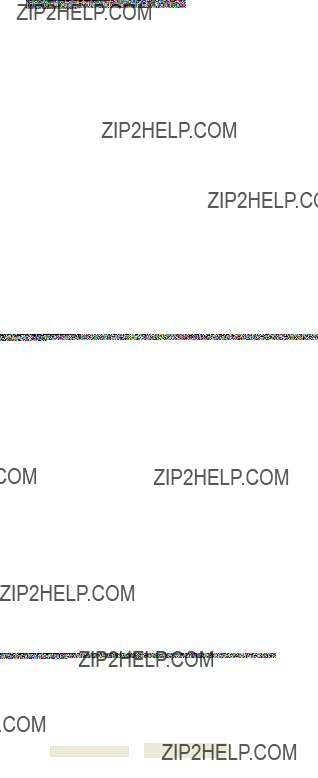
4. MAINTENANCE & TROUBLESHOOTING
4.3Restoring Default Settings
You may wish to restore all default settings to start operation afresh or to clear stray data. If you want to restore your previous settings, jot them down and restore them after clearing the memory.
1. Click System.
System menu
2. Click Test/Initialization.
3. Click Default setting.

4. MAINTENANCE & TROUBLESHOOTING
4. Click the Yes button.
5. Click the Yes button to restore all default settings.
4.4Finding Software Version
1. Click System > Test/Initialization > Version Information.
XX
XX
XX
XX
XX
XX.XX = Version and version no.
X = Board version no.
Version information
2. Click the Close button to quit.
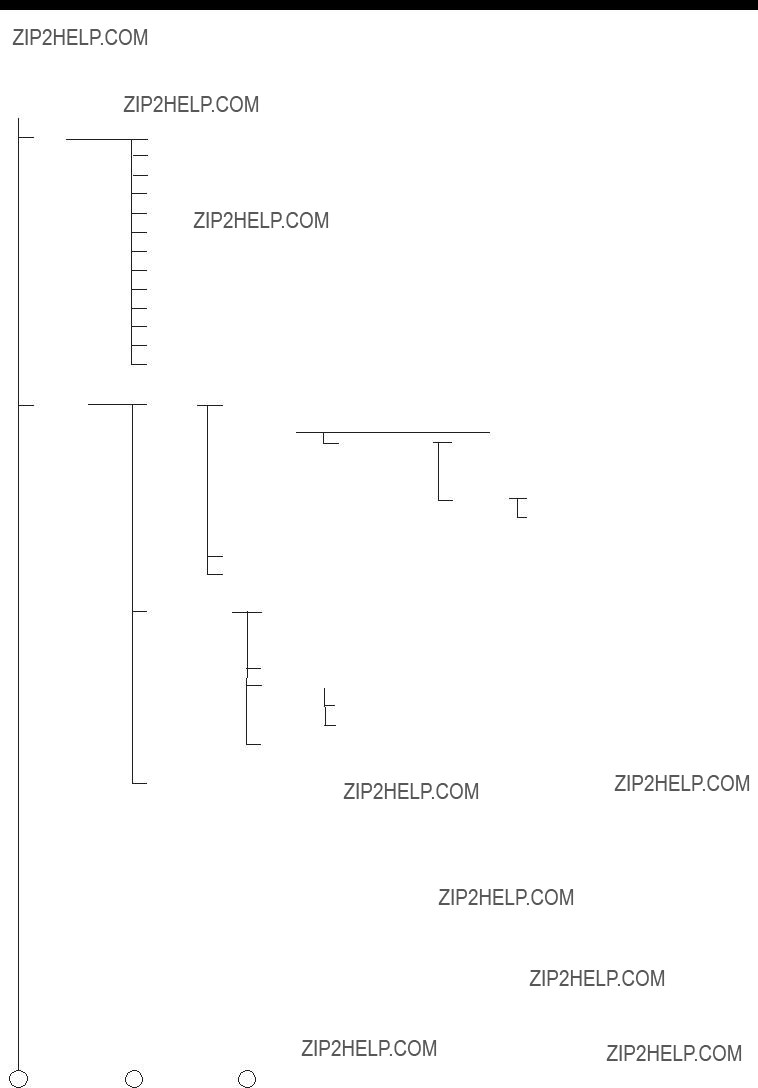
APPENDIX
Menu Tree
Menu bar File
TX Start
TX Stop
Record Play Stop Pause
Load the screen shot Save the screen shot Load user setting (1 - 20) Save user setting (1 - 20) Convert to HAC format
ETR
Quit
Screen layout (Vertical, Horizontal, Combination)

APPENDIX
1
4

APPENDIX

APPENDIX

APPENDIX
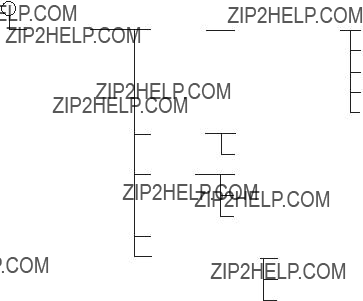
APPENDIX
Unit (m, ft, fa, hiro, P/B)

Screen Division
APPENDIX
Division: Left, Right
Division: Up, Down
Division: Combination

APPENDIX
A- scope display OFF
PIC1
PIC2 PIC1
PIC3 PIC2 PIC1
Division: Left, Right
PIC1
PIC2
PIC1
PIC2
PIC3
PIC1
PIC2
PIC3
PIC4
PIC1
PIC2
PIC3
PIC4
PIC5
Division: Up, Down
PIC1
PIC3 PIC2
PIC1
PIC4 PIC3 PIC2
PIC1
PIC5 PIC4 PIC3 PIC2
Division: Combination
SPECIFICATIONS OF THE COLOR VIDEO SOUNDER
1.DISPLAY
2.TRANSCEIVER
3.DATA I/O
SDDBS, SDDBT, SDDPT, SDTLL, YCMTW, SDvrm, SDbtm
4.POWER SUPPLY
FURUNO
6.COATING COLOR

INDEX
Furuno Electric Co., Ltd. Terms (EULA)
???You have acquired a device (???DEVICE???) that includes software licensed by Furuno Electric Co., Ltd from an affiliate of Microsoft Corporation (???MS???). Those installed software products of MS origin, as well as associated media, printed materials, and ???online??? or electronic documentation (???SOFTWARE???) are protected by international intellectual property laws and treaties. Manufacturer, MS and its suppliers (including Microsoft Corporation) own the title, copyright, and other intellectual property rights in the SOFTWARE. The SOFTWARE is licensed, not sold. All rights reserved.
???This EULA is valid and grants the
???IF YOU DO NOT AGREE TO THIS END USER LICENSE AGREEMENT (???EULA???), DO NOT USE THE DEVICE OR COPY THE
SOFTWARE. INSTEAD, PROMPTLY CONTACT FURUNO ELECTRIC CO., LTD. FOR INSTRUCTIONS ON RETURN OF THE
UNUSED DEVICE(S) FOR A REFUND. ANY USE OF THE SOFTWARE, INCLUDING BUT NOT LIMITED TO USE ON THE
DEVICE, WILL CONSTITUTE YOUR AGREEMENT TO THIS EULA (OR RATIFICATION OF ANY PREVIOUS CONSENT).
???GRANT OF SOFTWARE LICENSE. This EULA grants you the following license:
You may use the SOFTWARE only on the DEVICE.
If you use the DEVICE to access or utilize the services or functionality of Microsoft Windows Server products (such as Microsoft Windows Server 2003), or use the DEVICE to permit workstation or computing devices to access or utilize the services or functionality of Microsoft Windows Server products, you may be required to obtain a Client Access License for the DEVICE and/or each such workstation or computing device. Please refer to the end user license agreement for your Microsoft Windows Server product for additional information.
NOT FAULT TOLERANT. THE SOFTWARE IS NOT FAULT TOLERANT. FURUNO ELECTRIC CO., LTD. HAS
INDEPENDENTLY DETERMINED HOW TO USE THE SOFTWARE IN THE DEVICE, AND MS HAS RELIED UPON
FURUNO ELECTRIC CO., LTD. TO CONDUCT SUFFICIENT TESTING TO DETERMINE THAT THE SOFTWARE IS
SUITABLE FOR SUCH USE.
NO WARRANTIES FOR THE SOFTWARE. THE SOFTWARE is provided ???AS IS??? and with all faults. THE ENTIRE
RISK AS TO SATISFACTORY QUALITY, PERFORMANCE, ACCURACY, AND EFFORT (INCLUDING LACK OF
NEGLIGENCE) IS WITH YOU. ALSO, THERE IS NO WARRANTY AGAINST INTERFERENCE WITH YOUR
ENJOYMENT OF THE SOFTWARE OR AGAINST INFRINGEMENT. IF YOU HAVE RECEIVED ANY
WARRANTIES REGARDING THE DEVICE OR THE SOFTWARE, THOSE WARRANTIES DO NOT
ORIGINATE FROM, AND ARE NOT BINDING ON, MS.
No Liability for Certain Damages. EXCEPT AS PROHIBITED BY LAW, MS SHALL HAVE NO LIABILITY FOR
ANY INDIRECT, SPECIAL, CONSEQUENTIAL OR INCIDENTAL DAMAGES ARISING FROM OR IN
CONNECTION WITH THE USE OR PERFORMANCE OF THE SOFTWARE. THIS LIMITATION SHALL
APPLY EVEN IF ANY REMEDY FAILS OF ITS ESSENTIAL PURPOSE. IN NO EVENT SHALL MS BE LIABLE FOR ANY AMOUNT IN EXCESS OF U.S. TWO HUNDRED FIFTY DOLLARS (U.S.$250.00).
Restricted Uses. The SOFTWARE is not designed or intended for use or resale in hazardous environments requiring fail- safe performance, such as in the operation of nuclear facilities, aircraft navigation or communication systems, air traffic control, or other devices or systems in which a malfunction of the SOFTWARE would result in foreseeable risk of injury or death to the operator of the device or system, or to others.
Limitations on Reverse Engineering, Decompilation, and Disassembly. You may not reverse engineer, decompile, or disassemble the SOFTWARE, except and only to the extent that such activity is expressly permitted by applicable law notwithstanding this limitation.
SOFTWARE as a Component of the DEVICE - Transfer. This license may not be shared, transferred to or used concurrently on different computers. The SOFTWARE is licensed with the DEVICE as a single integrated product and may only be used with the DEVICE. If the SOFTWARE is not accompanied by a DEVICE, you may not use the SOFTWARE. You may permanently transfer all of your rights under this EULA only as part of a permanent sale or transfer of the DEVICE, provided you retain no copies of the SOFTWARE. If the SOFTWARE is an upgrade, any transfer must also include all prior versions of the SOFTWARE. This transfer must also include the Certificate of Authenticity label. The transfer may not be an indirect transfer, such as a consignment. Prior to the transfer, the end user receiving the SOFTWARE must agree to all the EULA terms.
Consent to Use of Data. You agree that MS, Microsoft Corporation and their affiliates may collect and use technical information gathered in any manner as part of product support services related to the SOFTWARE. MS, Microsoft Corporation and their affiliates may use this information solely to improve their products or to provide customized services or technologies to you. MS, Microsoft Corporation and their affiliates may disclose this information to others, but not in a form that personally identifies you.
Internet Gaming/Update Features. If the SOFTWARE provides, and you choose to utilize, the Internet gaming or update features within the SOFTWARE, it is necessary to use certain computer system, hardware, and software information to implement the features. By using these features, you explicitly authorize MS, Microsoft Corporation and/or their designated agent to use this information solely to improve their products or to provide customized services or technologies to you. MS or Microsoft Corporation may disclose this information to others, but not in a form that personally identifies you.
Links to Third Party Sites. You may link to third party sites through the use of the SOFTWARE. The third party sites are not under the control of MS or Microsoft Corporation, and MS or Microsoft are not responsible for the contents of any third party sites, any links contained in third party sites, or any changes or updates to third party sites. MS or Microsoft Corporation is not responsible for webcasting or any other form of transmission received from any third party sites. MS or Microsoft Corporation are providing these links to third party sites to you only as a convenience, and the inclusion of any link does not imply an endorsement by MS or Microsoft Corporation of the third party site.
Notice Regarding Security. To help protect against breaches of security and malicious software, periodically back up your data and system information, use security features such as firewalls, and install and use security updates.
No Rental/Commercial Hosting. You may not rent, lease, lend or provide commercial hosting services with the SOFTWARE to others.
Separation of Components. The SOFTWARE is licensed as a single product. Its component parts may not be separated for use on more than one computer.
Additional Software/Services. This EULA applies to updates, supplements,
EXTENT PERMITTED BY APPLICABLE LAW, THE SUPPLEMENTAL COMPONENTS AND ANY (IF ANY)
SUPPORT SERVICES RELATED TO THE SUPPLEMENTAL COMPONENTS ARE PROVIDED AS IS AND WITH
ALL FAULTS. ALL OTHER DISCLAIMERS, LIMITATION OF DAMAGES, AND SPECIAL PROVISIONS
PROVIDED BELOW AND/OR OTHERWISE WITH THE SOFTWARE SHALL APPLY TO SUCH SUPPLEMENTAL COMPONENTS. MS, Microsoft Corporation or their subsidiaries reserve the right to discontinue any
Recovery Media. If SOFTWARE is provided by Furuno Electric Co., Ltd. on separate media and labeled ???Recovery Media??? you may use the Recovery Media solely to restore or reinstall the SOFTWARE originally installed on the DEVICE.
Backup Copy. You may make one (1) backup copy of the SOFTWARE. You may use this backup copy solely for your archival purposes and to reinstall the SOFTWARE on the DEVICE. Except as expressly provided in this EULA or by local law, you may not otherwise make copies of the SOFTWARE, including the printed materials accompanying the SOFTWARE. You may not loan, rent, lend or otherwise transfer the backup copy to another user.
End User Proof of License. If you acquired the SOFTWARE on a DEVICE, or on a compact disc or other media, a genuine Microsoft ???Proof of License???/Certificate of Authenticity label with a genuine copy of the SOFTWARE identifies a licensed copy of the SOFTWARE. To be valid, the label must be affixed to the DEVICE, or appear on Furuno Electric Co., Ltd.???s, software packaging. If you receive the label separately other than from Furuno Electric Co., Ltd.., it is invalid. You should keep the label on the DEVICE or packaging to prove that you are licensed to use the SOFTWARE.
Product Support. Product support for the SOFTWARE is not provided by MS, Microsoft Corporation, or their affiliates or subsidiaries. For product support, please refer to Furuno Electric Co., Ltd. support number provided in the documentation for the DEVICE. Should you have any questions concerning this EULA, or if you desire to contact Furuno Electric Co., Ltd. for any other reason, please refer to the address provided in the documentation for the DEVICE.
Termination. Without prejudice to any other rights, Furuno Electric Co., Ltd. may terminate this EULA if you fail to comply with the terms and conditions of this EULA. In such event, you must destroy all copies of the SOFTWARE and all of its component parts.
EXPORT RESTRICTIONS. You acknowledge that SOFTWARE is subject to U.S. and European Union export jurisdiction. You agree to comply with all applicable international and national laws that apply to the SOFTWARE, including the U.S. Export Administration Regulations, as well as